Gallery of additional pictures
Gallery 2: June 1964 - May 1977
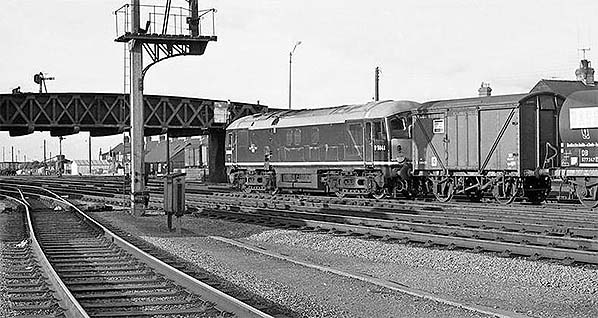 BR/Sulzer Type 2 No.D5048 approaches Mill Road bridge with a goods train in June 1964. The leading van is XP rated but the pipework does not appear to be connected to the tank wagon so the train is 'unfitted', meaning braking is provided only by the locomotive and brake van. What became Class 24 was a common sight at Cambridge, with some allocated to East Anglian sheds with others at Stratford and Finsbury Park. D5048 had been a Stratford locomotive but had moved to Ipswich when the above photograph was taken. By c1967/8 the type had left the area and D5048 herself ended up on the LMR Stoke Division. She survived until August 1975, having been renumbered 24048 the previous year. On Mill Road bridge, just above the locomotive's cab, the rarely photographed signal controlling the exit from the down goods yard can be seen (D5048 has used the station avoiding lines). It was a lower quadrant signal against a white backboard to aid sighting against the bridge. It is unfortunate that not too many detailed photographs of Mill Road bridge exist, probably because most photographers were at the other end of the station to see the Cambridge Buffet Express, so when the signal was removed cannot be precisely determined. However, it had gone by the mid-1970s and possibly during some signalling alterations which occurred in 1973. The 1926 lower quadrant signals on the other side of the bridge can be seen and these had theatre indicators. The bracket directly ahead of the camera held upper quadrant arms and gave instructions to down trains.
BR/Sulzer Type 2 No.D5048 approaches Mill Road bridge with a goods train in June 1964. The leading van is XP rated but the pipework does not appear to be connected to the tank wagon so the train is 'unfitted', meaning braking is provided only by the locomotive and brake van. What became Class 24 was a common sight at Cambridge, with some allocated to East Anglian sheds with others at Stratford and Finsbury Park. D5048 had been a Stratford locomotive but had moved to Ipswich when the above photograph was taken. By c1967/8 the type had left the area and D5048 herself ended up on the LMR Stoke Division. She survived until August 1975, having been renumbered 24048 the previous year. On Mill Road bridge, just above the locomotive's cab, the rarely photographed signal controlling the exit from the down goods yard can be seen (D5048 has used the station avoiding lines). It was a lower quadrant signal against a white backboard to aid sighting against the bridge. It is unfortunate that not too many detailed photographs of Mill Road bridge exist, probably because most photographers were at the other end of the station to see the Cambridge Buffet Express, so when the signal was removed cannot be precisely determined. However, it had gone by the mid-1970s and possibly during some signalling alterations which occurred in 1973. The 1926 lower quadrant signals on the other side of the bridge can be seen and these had theatre indicators. The bracket directly ahead of the camera held upper quadrant arms and gave instructions to down trains.
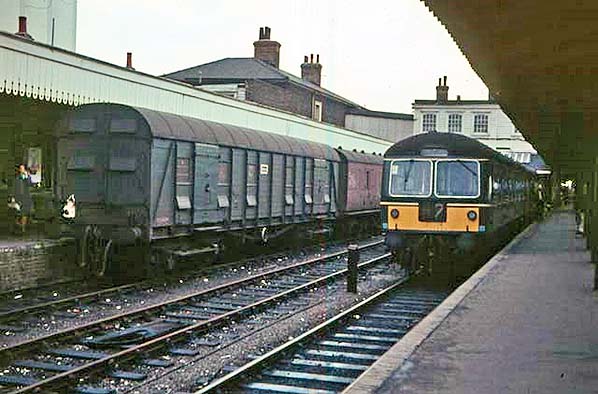 A green liveried 2-car Cravens DMU waits at platform 2 in October 1967 with a stopping service to Kings Cross. Of the two vans in platform 3, that partly hidden by the DMU appears to be an LMS designed 6-wheel passenger brake (Stove R) while that nearest the camera is more interesting. It is a Southern Railway designed scenery van and the history of these is worth a mention. The original SR examples were built on redundant London, Brighton & South Coast Railway underframes, made redundant due to the passenger bodies being given new underframes for use in electric multiple unit stock then being built. Later scenery vans were entirely new and continued to be built into BR days. The narrow body is noticeable; these vans were built to the restricted and so-called 'Hastings Gauge'. Scenery vans were so named as their purpose was to transport props and other equipment for theatre productions as they toured the country. They were also used for the same purpose by circuses, including for the transport of elephants and this was once a familiar sight at Cambridge (and numerous other places) when the circus came each year. Those used for elephants were modified in a number of ways including being given strengthened floors and these became known as 'Elephant Vans'. Over time this sort of traffic tailed of and scenery/elephant vans came to be used for general purposes, often being lumped into the CCT (Covered Carriage Truck) classification.
A green liveried 2-car Cravens DMU waits at platform 2 in October 1967 with a stopping service to Kings Cross. Of the two vans in platform 3, that partly hidden by the DMU appears to be an LMS designed 6-wheel passenger brake (Stove R) while that nearest the camera is more interesting. It is a Southern Railway designed scenery van and the history of these is worth a mention. The original SR examples were built on redundant London, Brighton & South Coast Railway underframes, made redundant due to the passenger bodies being given new underframes for use in electric multiple unit stock then being built. Later scenery vans were entirely new and continued to be built into BR days. The narrow body is noticeable; these vans were built to the restricted and so-called 'Hastings Gauge'. Scenery vans were so named as their purpose was to transport props and other equipment for theatre productions as they toured the country. They were also used for the same purpose by circuses, including for the transport of elephants and this was once a familiar sight at Cambridge (and numerous other places) when the circus came each year. Those used for elephants were modified in a number of ways including being given strengthened floors and these became known as 'Elephant Vans'. Over time this sort of traffic tailed of and scenery/elephant vans came to be used for general purposes, often being lumped into the CCT (Covered Carriage Truck) classification.
Photo by Geoffrey Skelsey
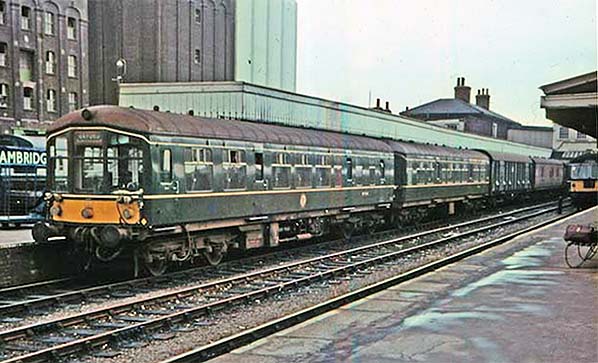 The Derby Lightweight unit from the Bletchley line, as mentioned in the previous caption, has arrived at platform 3. The tail lamp had already been removed and the destination shows Oxford and this was the 11.22 SO service on 7 October 1967. Cravens have yet to rasp out of the station and one suspects it is the photographer's bag on the platform seat. Dr Beeching usually attracts only negative reactions with little, if any, mention of the positive things he did for the railways. One of the latter was a new corporate image and replacement of the drab liveries then in use. This was the beginning of what came to be known as Rail Blue and the blue-grey coaching stock livery, first appearing in 1964 on the experimental XP4 train. Blue and blue/grey was officially made the new livery in June 1966, after a number of ghastly and not-so-ghastly livery experiments involving varying shades and applications. In the sidings behind platform 3 a vehicle in blue/grey livery can just be seen.
The Derby Lightweight unit from the Bletchley line, as mentioned in the previous caption, has arrived at platform 3. The tail lamp had already been removed and the destination shows Oxford and this was the 11.22 SO service on 7 October 1967. Cravens have yet to rasp out of the station and one suspects it is the photographer's bag on the platform seat. Dr Beeching usually attracts only negative reactions with little, if any, mention of the positive things he did for the railways. One of the latter was a new corporate image and replacement of the drab liveries then in use. This was the beginning of what came to be known as Rail Blue and the blue-grey coaching stock livery, first appearing in 1964 on the experimental XP4 train. Blue and blue/grey was officially made the new livery in June 1966, after a number of ghastly and not-so-ghastly livery experiments involving varying shades and applications. In the sidings behind platform 3 a vehicle in blue/grey livery can just be seen.
Photo by Geoffrey Skelsey
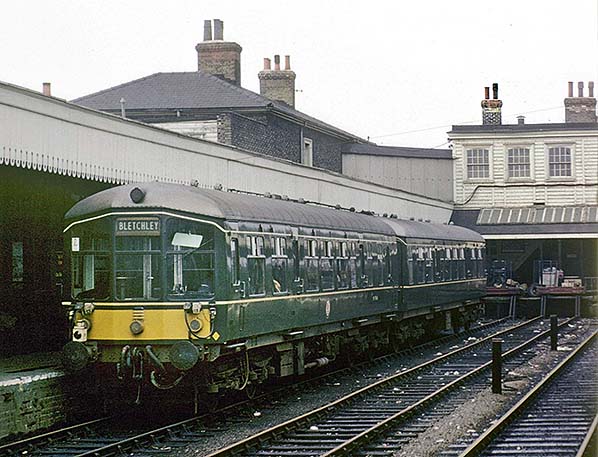 A Derby Lightweight DMU has arrived at platform 3 from the Bletchley line on 5 December 1967 a few weeks before closure of the line. It is an LMR set, as most were on this line, but the car numbers are not recorded.
A Derby Lightweight DMU has arrived at platform 3 from the Bletchley line on 5 December 1967 a few weeks before closure of the line. It is an LMR set, as most were on this line, but the car numbers are not recorded.
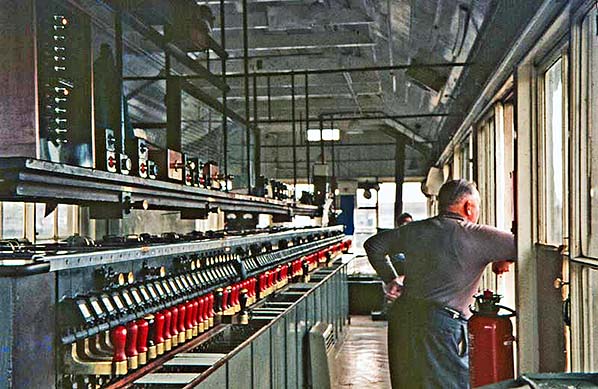 Two views of Cambridge South signal box interior in September 1974. The upper view is looking towards Hills Road bridge while the lower view is looking through the rear of the box towards the former GER goods shed. The equipment is that installed in 1926 and was electrically operated, replacing the mechanical levers of the original Cambridge signal boxes. The red levers, actually and for all intents and purposes large switches, were for 'stop' signals and the black ones for points. The numbers corresponded to points and signals indicated on the diagram above. In the early post-Grouping years, coincidentally at the time the electric Cambridge North and South boxes were built and fitted out, much effort was being being put into standardising signalling and the colours of signal box equipment across the entire network. Previously there had been a number of variations, especially with regard to distant signals, which harked back to the plethora of independent railway companies of the mid-19th century. With regard to the electric signal boxes at Cambridge, somebody with a working knowledge of the boxes would be needed to give a detailed description of the equipment so perhaps some readers may be able to help.
Two views of Cambridge South signal box interior in September 1974. The upper view is looking towards Hills Road bridge while the lower view is looking through the rear of the box towards the former GER goods shed. The equipment is that installed in 1926 and was electrically operated, replacing the mechanical levers of the original Cambridge signal boxes. The red levers, actually and for all intents and purposes large switches, were for 'stop' signals and the black ones for points. The numbers corresponded to points and signals indicated on the diagram above. In the early post-Grouping years, coincidentally at the time the electric Cambridge North and South boxes were built and fitted out, much effort was being being put into standardising signalling and the colours of signal box equipment across the entire network. Previously there had been a number of variations, especially with regard to distant signals, which harked back to the plethora of independent railway companies of the mid-19th century. With regard to the electric signal boxes at Cambridge, somebody with a working knowledge of the boxes would be needed to give a detailed description of the equipment so perhaps some readers may be able to help.
Photo by Geoffrey Skelsey
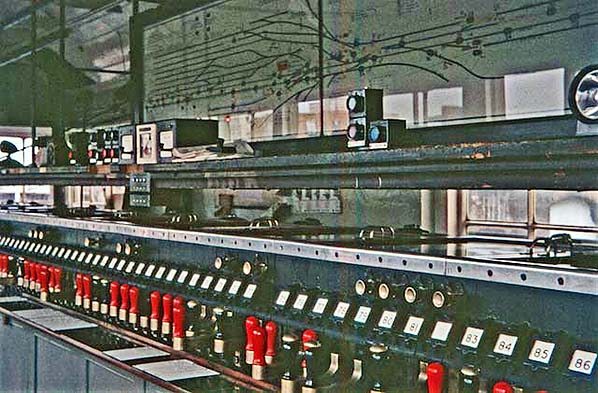
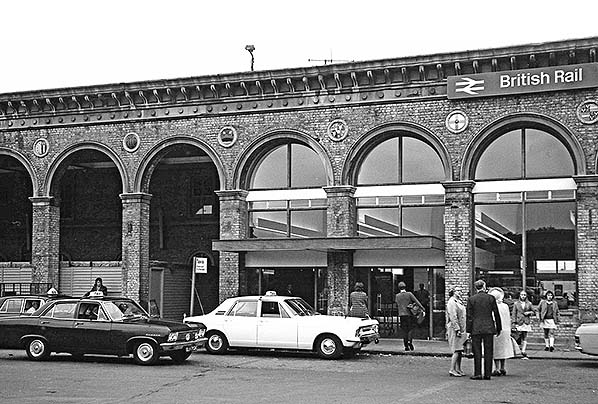 Cambridge station frontage, reportedly in 1971. This was the year during which the booking office was revamped; the new office being that behind the window on the right. The earlier canopy over the entrance has also gone and been replaced by the far-from-inspiring effort as seen above. At top right, a simple but neat British Rail sign has appeared but unfortunately the station frontage is asymmetrical. Appearances were also spoiled by the shed beneath the colonnade. Today the colonnade is entirely enclosed and an M&S buffet-cum-shop now occupies the spot where the shed once stood. The taxi on the left and nearest the camera is a 1967 (it is E registration) Vauxhall Cresta PC; this version being in effect a scaled down Chevrolet Impala and produced 1965 - 1972. The light coloured taxi is either a Ford Zephyr Mark IV or a Zodiac Mark IV. It appears to have two headlamps which makes it a Zephyr, the Zodiac having four headlamps. Both versions were in production 1966 - 1972. Some of the clothing styles seen above hark back a decade but the young man standing behind the Vauxhall Cresta displays the familiar 1970s hair style. Perhaps he is wearing a velvet jacket and tight, flared jeans!
Cambridge station frontage, reportedly in 1971. This was the year during which the booking office was revamped; the new office being that behind the window on the right. The earlier canopy over the entrance has also gone and been replaced by the far-from-inspiring effort as seen above. At top right, a simple but neat British Rail sign has appeared but unfortunately the station frontage is asymmetrical. Appearances were also spoiled by the shed beneath the colonnade. Today the colonnade is entirely enclosed and an M&S buffet-cum-shop now occupies the spot where the shed once stood. The taxi on the left and nearest the camera is a 1967 (it is E registration) Vauxhall Cresta PC; this version being in effect a scaled down Chevrolet Impala and produced 1965 - 1972. The light coloured taxi is either a Ford Zephyr Mark IV or a Zodiac Mark IV. It appears to have two headlamps which makes it a Zephyr, the Zodiac having four headlamps. Both versions were in production 1966 - 1972. Some of the clothing styles seen above hark back a decade but the young man standing behind the Vauxhall Cresta displays the familiar 1970s hair style. Perhaps he is wearing a velvet jacket and tight, flared jeans!
Photo by Roy Dixon from Kevin Lane's Flickr photostream
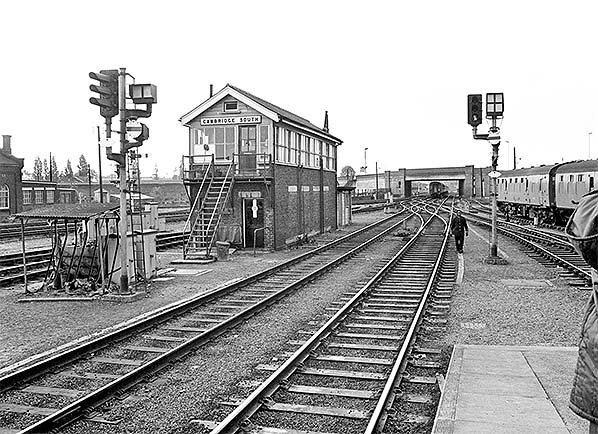 Cambridge South in 1976 from the end of platform 1. A Locomotive hauled train has just departed while a Cravens DMU arrives at platform 3, most probably from King's Cross. Note the odd mix of colour-light and semaphore signals. The other two devices behind the semaphore arm ahead of the camera are indicators giving additional information to drivers. The white discs with red bar are shunt signals.
Cambridge South in 1976 from the end of platform 1. A Locomotive hauled train has just departed while a Cravens DMU arrives at platform 3, most probably from King's Cross. Note the odd mix of colour-light and semaphore signals. The other two devices behind the semaphore arm ahead of the camera are indicators giving additional information to drivers. The white discs with red bar are shunt signals.
Photo
by David Burrows from his Flickr photostream
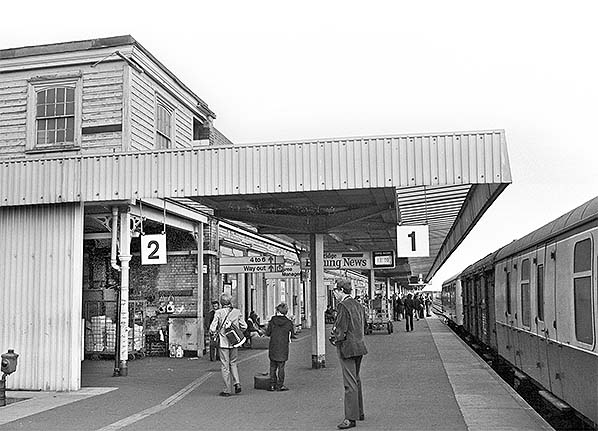 The dreadfully unwelcoming state of Cambridge station in 1976. This view is looking north with the south bay just off the picture to the left. Signage is all the, then, standard corporate black and white type; this innovation originated with Dr Beeching as part of a scheme for a uniform network-wide image but it took two decades to come to fruition on a large scale. This signage completely lacked the character of the regionally coloured enamel signage but at least it was easy to read and especially at night. The old signage, especially totems, was not always easy to read from trains during the hours of darkness. The Cambridge Evening News advertisment-cum-clock was a feature of the station for many years and was illuminated at night. There was once two of these, the other being located just north of the ticket barrier. On the right, a parcels train waits at platform 1 with a Cravens DMU car apparently attached. This practice was quite common when, say, a DMU car was returning from a works overhaul to its home depot or being transferred.
The dreadfully unwelcoming state of Cambridge station in 1976. This view is looking north with the south bay just off the picture to the left. Signage is all the, then, standard corporate black and white type; this innovation originated with Dr Beeching as part of a scheme for a uniform network-wide image but it took two decades to come to fruition on a large scale. This signage completely lacked the character of the regionally coloured enamel signage but at least it was easy to read and especially at night. The old signage, especially totems, was not always easy to read from trains during the hours of darkness. The Cambridge Evening News advertisment-cum-clock was a feature of the station for many years and was illuminated at night. There was once two of these, the other being located just north of the ticket barrier. On the right, a parcels train waits at platform 1 with a Cravens DMU car apparently attached. This practice was quite common when, say, a DMU car was returning from a works overhaul to its home depot or being transferred.
Photo
by David Burrows from his Flickr photostream
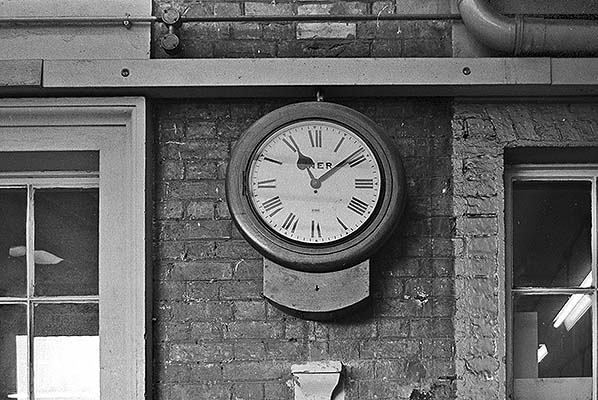 On the wall of platform 1 a lovely English drop-dial clock can be seen, or rather it was once a lovely English drop-dial clock; it had been totally ruined by a crudely executed conversion into synchronous electric form. In ruined form it was supplied with power from the conduit running above it. Synchronous clocks use the frequency of the AC mains supply to keep time and are extremely accurate, especially today with power station outputs accurately regulated.
On the wall of platform 1 a lovely English drop-dial clock can be seen, or rather it was once a lovely English drop-dial clock; it had been totally ruined by a crudely executed conversion into synchronous electric form. In ruined form it was supplied with power from the conduit running above it. Synchronous clocks use the frequency of the AC mains supply to keep time and are extremely accurate, especially today with power station outputs accurately regulated.
Photo
by David Burrows from his Flickr photostream
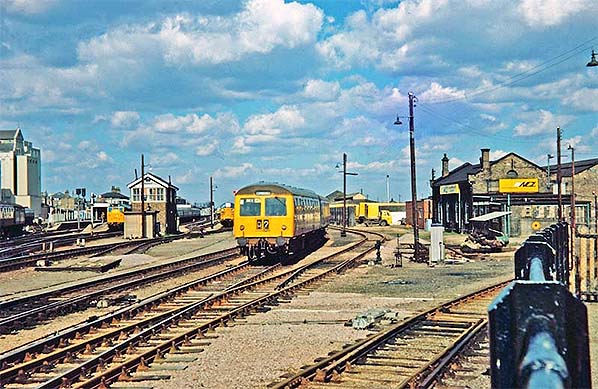 A typically bland Cambridge scene from the cattle market railings in April 1977. A Norwich-based DMU is heading south on the up goods line and will probably reverse into the south bay having come from Coldham's Lane depot. It has probably used the goods loop because a down passenger train is due and which will pass the Class 31 at platform 1 and use the scissors crossing the gain platform 4. Two Class 37's can be seen in the carriage sidings. On the right, most of the GER goods shed has been demolished but, far right, the GNR goods shed still stands. The DMU is a hybrid, with a Cravens driving trailer and what appears to be a Gloucester Class 100 driving motor. The Class 31 is dispaying a Domino headcode. This embellishment first appeared in 1972, on a Deltic, although the decision to abolish the displaying of headcodes was not formally taken until 1973 and even then took some years to fully implement. The proper term for a headcode is 'Train Reporting Number' but this was rarely used outside of the railway industry. Headcodes are still in use today but, of course, are no longer displayed. The reason for displaying them on trains was to permit identification of trains by staff, in particular signalmen, but with the advent of power signal boxes and the electronic systems used in them, headcode displaying was deemed unnecessary. The DMU still retains its 2-character headcode box. Dominos also appeared on DMUs but many had their headcode boxes plated over as
A typically bland Cambridge scene from the cattle market railings in April 1977. A Norwich-based DMU is heading south on the up goods line and will probably reverse into the south bay having come from Coldham's Lane depot. It has probably used the goods loop because a down passenger train is due and which will pass the Class 31 at platform 1 and use the scissors crossing the gain platform 4. Two Class 37's can be seen in the carriage sidings. On the right, most of the GER goods shed has been demolished but, far right, the GNR goods shed still stands. The DMU is a hybrid, with a Cravens driving trailer and what appears to be a Gloucester Class 100 driving motor. The Class 31 is dispaying a Domino headcode. This embellishment first appeared in 1972, on a Deltic, although the decision to abolish the displaying of headcodes was not formally taken until 1973 and even then took some years to fully implement. The proper term for a headcode is 'Train Reporting Number' but this was rarely used outside of the railway industry. Headcodes are still in use today but, of course, are no longer displayed. The reason for displaying them on trains was to permit identification of trains by staff, in particular signalmen, but with the advent of power signal boxes and the electronic systems used in them, headcode displaying was deemed unnecessary. The DMU still retains its 2-character headcode box. Dominos also appeared on DMUs but many had their headcode boxes plated over as
ultimately did most locomotives
Photo by Geoffrey Skelsey
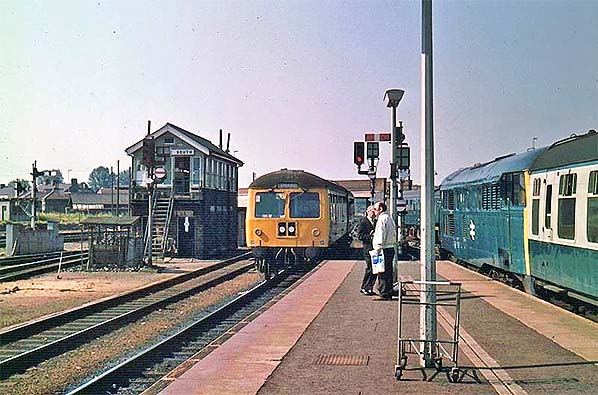
The south end of Cambridge station in May 1977. Cravens, complete with domino headcode, is arriving at platform 1. This is a Norwich based unit, as indicated by the set number in the windscreen, so will have come from Bishop's Stortford. This shuttle service called at all stations and ran in between Liverpool Street trains. It connected with electric trains at Bishop's Stortford and anybody wishing to make an intermediate journey, such as Shelford to Bruce Grove or Great Chesterford to Turkey Street, faced a slow and tedious ordeal. The Class 31 is working a King's Cross 'Buffet Express' service. Note the odd mix of colour-light and semaphore signals. The other two devices behind the semaphore arm ahead of the camera are indicators giving additional information to drivers. The white discs with red bar are shunt signals. The luggage trolley is roughly on the site of the original Cambridge South signal box.
Photo by Geoffrey Skelsey
Click here for Gallery 3: May 1977 - September 1993

